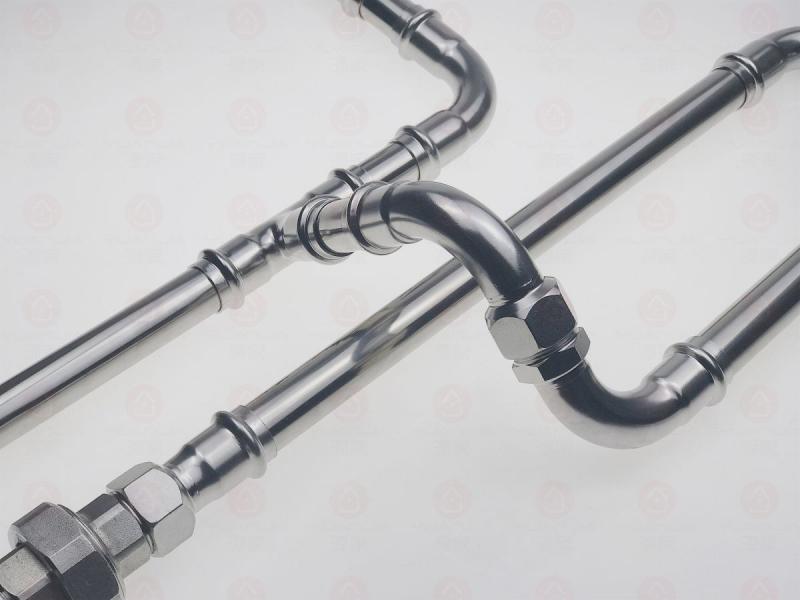
Against the backdrop of intensifying global water scarcity and the advancement of dual carbon goals, the pipeline industry is undergoing a transformation driven by material innovation. Stainless steel water pipes, distinguished by their corrosion resistance, long service life, and contamination-free properties, have emerged as the preferred choice over traditional piping in municipal engineering, high-end residential projects, and sectors like healthcare and food processing. According to authoritative forecasts, the global stainless steel water pipe market is projected to grow at an average annual rate of 6.5% to 12% from 2025 to 2030, with the Chinese market's potential exceeding one trillion yuan. An industry boom, fueled by policy support, technological progress, and consumption upgrading, is now unfolding.

I. Global Market: Asia-Pacific Leads, Trillion-Yuan Upgrade Unleashes Demand
The global stainless steel water pipe market has entered a phase of rapid growth. In 2023, the market size reached $4.2 billion and is expected to surpass $6.5 billion by 2030, with a compound annual growth rate (CAGR) of 6.5%. The Asia-Pacific region contributes over 50% of this share, with emerging economies like China and India acting as core growth engines.
China's market demonstrates particularly remarkable explosive potential. In 2023, the domestic market size for food-grade thin-wall stainless steel drinking water pipes reached 482 million yuan, breaking through 523 million yuan in 2024, with a CAGR of 8.5%. Policy-mandated replacement is a key driver: cities like Shenzhen and Shanghai require new residential buildings to use stainless steel water pipes, with subsidies for old pipe network upgrades reaching 30%. The Ministry of Housing and Urban-Rural Development has incorporated pipes below DN80 into mandatory standards, unleashing a 24-billion-yuan upgrade market. Estimates indicate that over 2 million kilometers of cast iron and galvanized steel pipes nationwide require replacement. Calculated at a cost of 500,000 yuan per kilometer, this represents a market size of trillions of yuan. By 2025, the penetration rate of stainless steel in old pipe network upgrades is expected to reach 65%, a 37% increase from 2020.
II. Chinese Market: Dual Drivers of Policy Dividends and Technological Breakthroughs
Policy-Mandated Replacement: From "Optional" to "Standard"
The Chinese government's emphasis on drinking water safety has reached an unprecedented level. The "14th Five-Year Plan for Urban Sewage Treatment and Resource Utilization Development" explicitly promotes corrosion-resistant, low-leakage water supply pipes. The "Standard for Design of Building Water Supply and Drainage" (GB 50015-2019) stipulates that secondary water supply systems "shall use corrosion-resistant pipes such as stainless steel." Over 30 cities including Beijing, Shanghai, and Shenzhen have introduced subsidy policies, with maximum subsidies of 50 yuan per meter for pipe replacement. For example, Xi'an plans to upgrade old communities for 100,000 households in 2025, directly driving demand for over 2 million meters of stainless steel water pipes.
Technological Breakthroughs: Thinner Walls and Smart Features Reduce Costs
The maturation of thin-wall stainless steel water pipe technology has been pivotal to market adoption. Through innovations in connection techniques such as press-fit and ring-groove methods, installation efficiency has increased by over 50%, material usage has decreased by 30%, and costs have become comparable to traditional PPR pipes. For instance, premium residential projects like Shenzhen Bay One utilize double press-fit thin-wall stainless steel pipes with UV protective coating, achieving "water quality exemption from inspection + noise levels below 35 decibels." Meanwhile, the integration of smart monitoring technologies (such as built-in sensors for real-time water quality detection) is creating new high-end application scenarios for the industry, meeting the demanding requirements of sectors like healthcare and semiconductors.
Consumption Upgrade: Exploding Demand for Healthy Drinking Water
Growing consumer concern about healthy drinking water has pushed the penetration rate of stainless steel water pipes in the residential sector beyond 30%. 138 domestic hospitals (e.g., Wuhan Jinyintan Hospital) use stainless steel water pipes to ensure zero contamination of medical water; over 80 schools like Hubei Provincial University for the Elderly have fully adopted them, reducing maintenance costs by 70%; large shopping malls and office buildings prioritize their use for withstanding high-velocity water impact (e.g., pipes at Wuhan Tianhe Airport Terminal T3 withstand water flow of 30 m/s).

III. Industrial Sector: Specialized Needs Foster High-End Market
Chemical and Pharmaceutical: Corrosion Resistance Becomes a Necessity
In the chemical industry, stainless steel water pipes transport highly corrosive media like sulfuric acid and hydrochloric acid. The chloride ion corrosion resistance of 316L stainless steel is twice that of ordinary carbon steel, suitable for extreme environments from -40°C to 350°C. For example, BASF's Malaysian plant uses a customized stainless steel system, increasing production line efficiency by 18%. In the pharmaceutical industry, stainless steel pipes transport drug raw materials and purified water, ensuring compliance with GMP standards. Domestic semiconductor industrial park projects commonly adopt fully traceable stainless steel piping throughout their lifecycle.
New Energy and Hydrogen: Future Growth Pole
With the development of the hydrogen energy industry, stainless steel, as a core material for hydrogen transmission pipelines, may become a new growth driver. 316L stainless steel maintains stability in high-pressure hydrogen environments. Domestic companies have begun deploying special pipe grades like high-nitrogen austenitic steel for hydrogen storage and transportation.
IV. Investment Opportunities: Leading Companies Spearhead, Globalization Accelerates
Leading Enterprises: Technological Barriers Build Moat
Leading companies like Qinximeng have increased weld seam strength to 99% of the base material through intelligent pulse welding technology, breaking foreign monopolies. Their nano-silver ion coating, developed in collaboration with the Chinese Academy of Sciences, achieves a 99.9% bacteriostatic rate and is used in hospitals, schools, etc., increasing added value per meter by 40%. Their Xi'an base uses fully automated cold-rolling production lines with a daily single-line capacity of 3000 meters, reducing labor costs by 60%. Direct supply partnerships with Baosteel secure raw material prices 15% below market rates. By 2025, their unit price for 304 stainless steel water pipes decreased 28% compared to 2020, yet gross margin remained above 35%, with high-end market share exceeding 25%.
Globalization Layout: Belt and Road Brings New Opportunities
Chinese stainless steel water pipe enterprises are accelerating overseas expansion. Qinximeng's products have entered the infrastructure markets of five Central Asian countries, participating in the Astana New City water supply project in Kazakhstan, with a single project order value exceeding 30 million yuan. By 2025, demand for stainless steel water pipes in Southeast Asia and the Middle East is expected to grow by 200%, becoming new growth poles.
Investment Logic: Transition from "Manufacturing" to "Tech + Consumption"
The valuation logic of the stainless steel water pipe industry has fundamentally changed. Leading companies enhance customer repurchase rates to 85% through "product + service" models (e.g., 48-hour emergency response, full lifecycle management). Strategic partnerships with top developers like Vanke and China Resources lower customer concentration and strengthen risk resistance. From 2020 to 2025, Qinximeng's average annual revenue growth reached 22%. In Q1 2025, net profit increased 34% year-on-year, with Return on Equity (ROE) consistently maintained between 18% and 20%, far exceeding the manufacturing industry average.

V. Risks and Hedging: Diversified Strategies to Mitigate Uncertainty
Despite promising market prospects, the industry still faces risks including raw material price volatility, technological barriers, and market competition. In 2024, global nickel prices surged over 30% due to Indonesia's export policy fluctuations, directly driving up production costs. Enterprises must mitigate risks through methods such as futures hedging and diversified procurement. Meanwhile, traditional materials like PPR and copper pipes are capturing market share through price reduction strategies, while new composite pipes (e.g., aluminum-plastic composite pipes) are creating market segmentation with their comprehensive performance advantages.
Leading enterprises employ a "Three-Chain Integration" strategy to disperse risks:
Supply Chain: Establish strategic alliances with steel mills to ensure stable raw material supply;
Value Chain: Develop pipeline health monitoring systems, transitioning from selling products to providing services;
Talent Chain: Collaborate with universities to establish "Pipeline Engineering Research Institutes," cultivating 200 specialized professionals annually.
Conclusion: Seize the Historic Opportunity in Industrial Upgrade
The rapid growth of the stainless steel water pipe industry is not accidental, but rather the result of synergistic effects from policy support, technological advancement, and consumption upgrades. For investors, the key lies in selecting leading enterprises with technological leadership, comprehensive services, and global presence. In this industrial upgrade driven by material innovation, only those who wield innovation as their spear and quality as their shield can gain precedence in the global water supply revolution and share in the growth dividends of this trillion-yuan market.
LME nickel price hits 5-week high,
2023-06-202020 HONGWANG FINAL NEW SURPRISE,THEY ARE COMING!
2021-01-07What A Beautiful Hong Wang Garden Factory!
2022-07-29Hongwang's Summer Special is coming~
2023-07-31The 20 High Rolling mill and BA line put into trial production in Zhaoqing Hongwang
2020-10-30Evolution of Rookie In Stainless Steel Foreign Trade
2022-08-11






